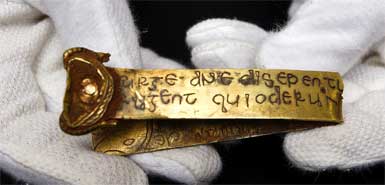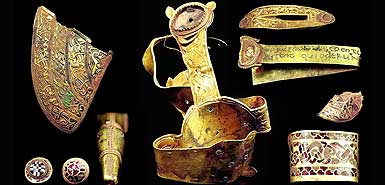It's a misty dawn in Middle England, some time in the 7th century. A small band of armed men struggle up a wooded hill. At the summit they pause. While one keeps watch, the others tip their loot on to the ground. They divide up the jewels and coins, then they turn to the rest of the booty: swords, crosses, saddle fittings, which are mostly gold and exquisitely made. They hammer at them with stones and the hilts of their knives, they rip the pommels from the swords and stuff the blades into their jerkins, smash the helmets and bend the arms of the crosses until they look like nothing more than twisted pieces of metal. They stuff the small gold and bejewelled fragments into leather pouches, grub out a hole in the earth, and bury their cache. Then they disappear over the hill as swiftly as they came.
Centuries pass: William the Conqueror's Normans arrive; the Tudors squabble over national control; Queen Victoria and the British Empire come and go. The hoard remains untouched - until 1,400 years later, when an amateur collector, Terry Herbert, rediscovers it on what is now a farm. Since Terry came across the treasure, now known as the Staffordshire Hoard, using a simple metal detector last July, the story behind it has captured the public imagination. The items he discovered - more than 1,500 pieces of beautifully crafted gold and silver - have been described as the most important Anglo-Saxon archeological evidence ever found in Britain. The battle to keep the bling in the country is well under way. The government would be unlikely to grant an export licence but it could still be split up and taken abroad illegally by a private collector. Despite all the furore, the hoard poses as many questions as it answers.
On a wet afternoon recently, I visited a Georgian townhouse near the Natural History Museum, where some of Britain's leading archeologists and Anglo-Saxon specialists had gathered. Among them were Dr Gareth Williams of the British Museum and Professor Simon Keynes of Cambridge University. They were there to answer my questions at the behest of The Art Fund, which is trying to raise the money to keep the hoard in the country. Why are the experts so excited about this stuff? Have we simply been seduced by the glitter of the gold? Isn't the hoard just a jumble of arbitrary undatable loot with no way of knowing who owned it or why it was buried?

We can't yet say which battle these spoils were from, or if they were from one or several battles. But the objects do embrace various artistic styles, showing they weren't made in the same place at the same time. The material comes from the social elite of 7th-century England - aristocracy, or even royalty. My experts tell me that much of it was almost certainly made by the very same craftsmen who made the Sutton Hoo riches.
So what does all this suggest? The Venerable Bede, a monk and historian writing in the early 8th century who was known for his reliable documentation, tells a complicated story of over-kings, kings, sub-kings and chieftains, all of whom would have had their own personal war bands. With gold fittings from over 80 swords, it is clear that not all the treasure has come from kings. Instead, we see evidence of a wealthy warring aristocracy.
Picture a society infused with battles and status. Your ability to fight and command guaranteed reputation and respect. Almost all men were buried with weapons, and nearly everyone was given a name that reflected battle: Hrothgar means "blood spear", Sigeberht "bright victory". Serving the king meant you had the opportunity to capture loot and have gifts bestowed on you: sword hilts or wealthy estates.
A symbol of the bond between a lord and his follower was the giving of treasure and war goods for loyalty and respect. But these often came at a high price, and warriors were expected to keep on fighting, even if the situation became hopeless. Fleeing the battlefield was not an option unless ordered by the chief.
Another theory has now emerged from the scrunched-up crosses in the hoard. Christianity came to Anglo-Saxon England in 597AD, but it was not until 686 that all English kingdoms were Christian. Some of my experts are sure that the crosses were spoils from a battle between Christians and Pagans, the latter being happy to vandalise the Christians' sacred symbols.
But if they are battle spoils, why the religious artefacts? Priests and monks often accompanied the warriors onto the battlefield, praying for the defeat of their enemies, say my experts. If they were trying to contribute to victory, they could also share in the defeat. Bede tells of the killing of 1,200 Welsh monks by the Northumbrian king Æthelfrith shortly after AD600. Is this hoard evidence of a massacre? Where are the coins, jewellery and ornamental objects we would normally find among such a hoard? The artefacts are masculine - the fittings from swords, fighting knives, helmets and shields - which point to a battle context. But why only take the decorative fittings, not the complete swords and helmets? These were more valuable if kept intact, yet all we have are fragments, broken, stripped from the weapons, and bagged up for easy burial.
All this suggests that the booty-snatchers were men in a hurry. It's not fanciful to imagine an army hotfooting along a medieval motorway, unwilling to shoulder the bulk of weapons it didn't need at the time. Having trounced the enemy, they could have pocketed the blades and the odd coin, then broken off the most splendid bits of finery, dropped them into a small trench and marched off down the campaign trail.
The men who took the plunder were well placed to move at speed. The hoard was buried near one of Britain's most important Roman roads, Watling Street (now the A5), the centre of Mercia and close to Lichfield, which already has two Anglo-Saxon treasures: the illuminated Lichfield Gospels, and a beautiful stone angel, a sublime piece of early English sculpture.
One possible invading force would have been the Welsh, a thorn in the side of their neighbours' kings right up to the 14th century. There is no better illustration of their troublesome nature than that greatest of Mercian monuments, Offa's Dyke, dug by the Mercian king of that name in the late-8th century, which did to the Welsh what Hadrian's Wall had done to the Picts of Caledonia. The Life of Saint Guthlac tells us one Mercian king, Cenred (704-9), was continually harassed by attacking Britons from Wales; could this be the residue from one such attack?
Perhaps. But the stuff doesn't look very Welsh; indeed, it almost smells Anglo-Saxon. Its decorations and styles are dead ringers for the objects found in English warrior graves. Maybe then we are seeing loot captured by the Welsh and buried before they headed further into Mercia in pursuit of yet more booty. If so, greed got the better of them - they probably met their deaths at the hand of the next army they crossed. Whoever was privy to the hiding place obviously met an untimely end before they could return.
The next day I visited the British Museum, where a few tiny artefacts from the hoard lie in isolated splendour. They are so precious I was watched by four nervous curators as I gingerly sorted through them. One thing is clear when you see them with the naked eye: life in the Dark Ages wasn't as gloomy and unsophisticated as the name implies, at least not for the elite.
What finds like this and the Lichfield Angel show is the importance of the Midlands to English history, and how England wasn't always dominated by London. In the late-7th century everything was up for grabs, and the Mercians, or Midlanders, grabbed it. Under a series of exceptional kings - Penda (died 655), Wulfhere (died 675), Æthelred (abdicated 704), Æthelbald (716-757), Offa (757-796) and Cenwulf (796-821) - Mercia became the most powerful kingdom in England, dominating East Anglia, Essex, Kent and Sussex. Though the Vikings eventually did for this Midlands empire, for nearly 200 years the Mercians were the force to be reckoned with. The hoard shows us a time when that extraordinary kingdom was establishing itself - making enemies, taking risks, gaining strength.
More than 45,000 people have been to see the hoard at the Potteries Museum in Stoke since it went on display there last month, and almost the same number saw it at the Birmingham Museum and Art Gallery last year. Public donations to The Art Fund's campaign to secure the hoard for the Midlands topped £500,000 in the first six weeks. But if more money isn't raised, ownership of the treasure will pass to Terry Herbert and the landowner who will then have the right to sell it to anyone on the open market. It would be wonderful if the region could keep this enigmatic addition to its heritage, and not lose it to a foreign museum or the gloomy vaults of a private collector. In the 7th century it seems a good many people fought hard to snatch this gold from Mercia. But that is where it belongs.




Reader Comments
to our Newsletter